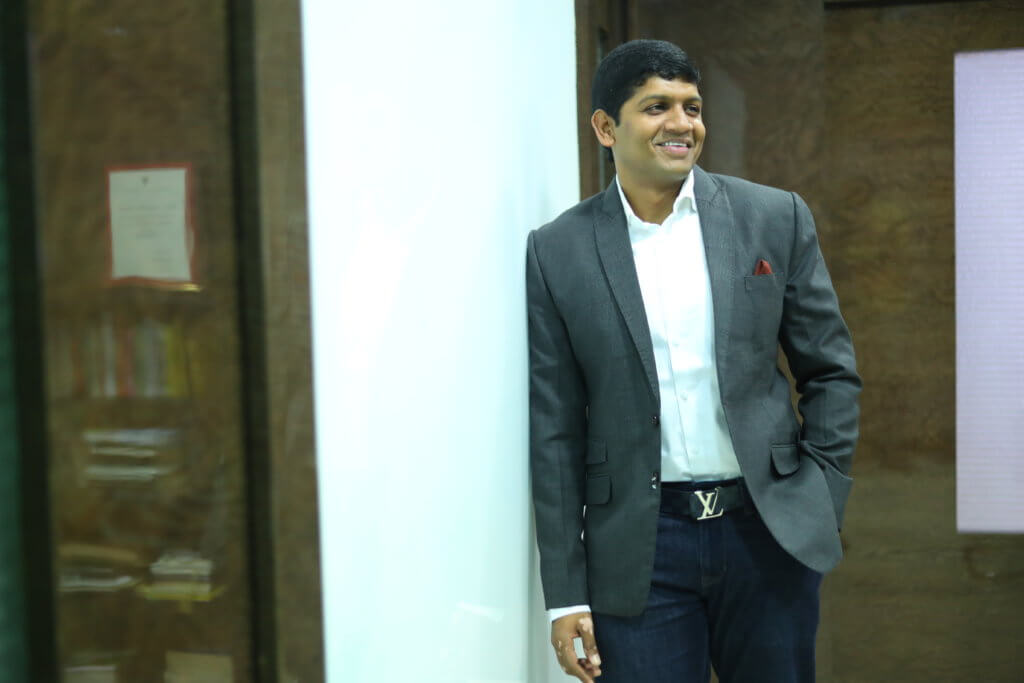For years, Krishna Nallamilli enjoyed a career outside of the family business, Aditya Educational Institutions. A self-described tech geek, Krishna was making waves in India’s Southern tech-hub Bangalore working as a software engineer.
In 2008, he agreed to come back and help out in the family business only after making himself a promise – if it was not working out after a year, he would happily return to his previous life. He never turned back.
Finding his place within the organisation, however, was no easy task. He had to build confidence in team members that did not see him as a legitimate leader and find a way of working with family members without jeopardising the relationship with them. Establishing boundaries to help separate the different parts of his life was the only way to move forward.
More than a decade later, Krishna leads two successful business. He remains Vice-Chairman at Aditya and is also Co-Founder and CTO of Kimo, an education-related venture he launched with a classmate he met while at Harvard Business School.
We sat down with Krishna Nallamilli to hear more about his journey.

What was it like to join the family business?
It took me almost two years just to understand everything that was happening around me. Coming directly from a software engineering background into this environment was a big shock.
I didn’t know how to manage my family relationships or professional relationships. I have many friends in family businesses, and it’s something we always talk about – how it’s impossible to prepare someone for this. Learning to thrive in a family business environment is an iterative process.
The ability to manage many different relationships simultaneously is key. There are family dynamics to contend with, and then, from a professional perspective, people may expect you to work in a different way than what you’ve already established elsewhere.
How did you find a balance?
My journey hasn’t been an easy one. I’ve had to make some tough decisions that offended my family from time to time. I’ve had to let some long-time employees go, which is never easy. I stayed my course, however, because I knew unequivocally that these were the right decisions to make.
About six months after I started, I realised that some of my employees did not accept the legitimacy of my leadership because, in their eyes, I was little more than a kid born with a silver spoon in his mouth. Several of our key employees were okay with my dad but not with me.
Instead of letting their disapproval distract me, I decided to focus on growth, finding ways to implement the changes that I knew were needed. I built a small team I trusted and with whom I could communicate. This involved promoting a few people that I saw as undervalued – my first line of defence. They became familiar with my leadership style, which allowed me to use them as a buffer to communicate my expectations with the rest of the staff.
At the same time, I made sure everyone knew I had an open-door policy, which is still in place today. If anybody has an issue, they can just walk into my office. Back then, some of those meetings kept me in the office until 10:30 or 11:00 at night.
“I saw that if I removed specific family dynamics from the equation, my problems weren’t unique. Others face the same struggles and overcome them.”
What has helped you grow as a leader?
When I joined the family business, I knew that I needed to expand my knowledge if I wanted to succeed. So, I spent a considerable amount of time reading books and trying to understand different perspectives. The biographies of other business leaders were helpful. I saw that if I removed specific family dynamics from the equation, my problems weren’t unique. Others face the same struggles and overcome them.
To expand my circle of knowledge in more of a homegrown way, I created a small support group of other family business leaders in the city who are mostly in a similar age bracket – 25 to 45. We meet up once a week for about an hour to exchange ideas and share experiences.
This community is a blessing. If someone needs to complain about their father, they can share what happened, and they know they are talking to a group who can understand and appreciate what they are going through.
I augment these practices with travel, where I continue to learn by meeting like-minded people at conferences and other business events. I’ll make a dedicated trip to the US or UK to meet people and hear from them how they run their business, with a particular interest in how they implement change and initiate new projects. If I want to introduce something new, I do not need approval from my employees, but I do need the support of my family.
What is your working relationship with your brother like?
We are still miles apart in terms of where and how we work. When my father stepped down, we were each given our own vertical, and there are only a few areas of overlap between these verticals. Despite being in the business together for almost 12 years, our professional paths have crossed only five or six times. There’s never been a situation where we felt we were impinging on each other’s territory.
That said, we value each other’s perspective and advise each other in a professional capacity. Every once in a while, we’ll call each other to talk about the challenges we are facing. I’ll give him my suggestions and vice versa.
“Through Kimo’s development, I’ve evolved as a leader, and my roles have changed as a result. Now, on top of serving as head of operations and finance, I bring strategy and innovation to the family business as well.”
How do you incorporate your passion for technology?
I didn’t at first, but eventually, I realised that in leaving this part of my life behind, I wasn’t utilising my core strengths. So, I came up with some ways we could use technology to improve the learning experience. There are many flaws in the way we learn and teach – we wanted to find a system that changed that. That’s how Kimo was born.
Kimo is a content curation platform that makes current educational models more efficient. Our core belief is that personalisation should be part of the content design itself. Kimo is an AI and machine learning platform that adapts content to suit the unique learning needs of the individual better.
Through Kimo’s development, I’ve evolved as a leader, and my roles have changed as a result. Now, on top of serving as head of operations and finance, I bring strategy and innovation to the family business as well.
Kimo operates separately from Aditya, but it is, of course, related to it almost in a symbiotic way. Being the Co-Founder and CTO of a small team scattered around the world provides tremendous growth and learning opportunities.
[ms-protect-content id=”4069,4129″]
What advice do you give to someone who is about to join their family business?
My first piece of advice: work up through the business rather than starting at a C-Suite-level position. Begin with small projects – no more than 10 to 15 employees. Show that you can handle responsibility managing both people and deadlines. If the organisation lacks confidence in your ability, there is no point in sitting in a high-level leadership position.
My second piece of advice: work outside the family business for at least two or three years beforehand. Learn about duty and humbleness. Before I joined the family business, I worked at a software company in Bangalore, where I learned to work with a professional team even though we didn’t get along personally. Exclusivity is critical; if I weren’t able to keep the two separate, my professional role would have been compromised.
“We need separation between the family and the business, which means having people to help us find the right roles. We need a CEO who can take a high-level viewpoint while leaving day-to-day management to others.”
Where else is this separation important?
Boundaries are important when it comes to the future. In the family business, we are trying to implement a professional structure that can establish boundaries between business life and family life. My son is seven years old, and I have nieces who are ten and four. We talk as if their part in the family business has already been decided.
When my brother and I joined Aditya, the company was relatively small, so it was a relatively easy transition. By the time our kids are old enough to enter the business, it’s going to be much larger. How can we adequately equip them to step into an organisation and lead 10,000 people?
To do this, we need separation between the family and the business, which means having people to help us find the right roles. We need a CEO who can take a high-level viewpoint while leaving day-to-day management to others. I do not want to leave my family business before implementing a professional structure and ensuring it is on the right path.
I wish to concentrate on building a company that can impact 7.5 billion people instead of 75,000 people. Learning is personalised, but education doesn’t yet reflect this reality. We can change that.
[/ms-protect-content]














